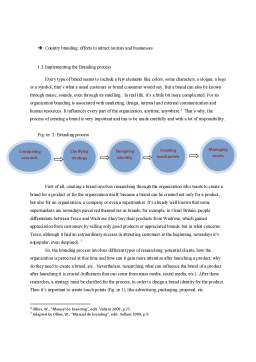Extras din referat
1. Basic Brand and Branding Concepts
1.1. What is brand?
First of all we need to define brand, what represents it and the branding process, in order to be able to learn how to create a brand after all.
As competition creates infinite choices, companies look for ways to connect emotionally with customers, become irreplaceable, and create lifelong relationships. A strong brand stands out in a densely crowded marketplace. People fall in love with brands, trust them, and believe in their superiority. How a brand is perceived affects its success, regardless of whether it’s a start-up, a nonprofit, or a product.
Fig. nr. 1: Brand touchpoints
“The best brands marry intelligence and insight with imagination and craft. “
Connie Birdsall, Creative Director, Lippincott
A brand is a name, symbol, or other feature that distinguishes a seller's goods or services in the marketplace. More than 500,000 brands are registered globally with pertinent regulatory bodies in different countries. Brands serve their owners by allowing them to cultivate customer recognition of, and loyalty toward, their offerings. Brands also serve the consumer by supplying information about the quality, origin, and value of goods and services. Without brands to guide buying decisions, the free market would become a confusing, faceless crowd of consumables. An established and respected brand can be the most valuable asset a company possesses.
Brands have been used since ancient times. For example, people burned singular designs into the skin of their livestock to prove ownership, while potters and silversmiths marked their wares with initials or other personal tags. But it is only since the second half of the nineteenth century that branding evolved into an advanced marketing tool. The industrial revolution, new communication systems, and improved modes of transporting goods made it both easier and more necessary for companies to advertise brands over larger regions. As manufacturers gained access to national markets, numerous brand names were born that would achieve legendary U.S. and global status. Procter and Gamble, Kraft, Heinz, Coca-Cola, Kodak, and Sears were a few of the initial brands that would become common household names by the mid-1900s. Before long, legal systems were devised to recognize and protect brand names, and branding was extended to services—such as car repair—as well as products. Thus the brand concept moved into the forefront of modern advertising strategy.
1.2. What is branding?
Branding is a disciplined process used to build awareness and extend customer loyalty. It requires a mandate from the top and readiness to invest in the future. Branding is about seizing every opportunity to express why people should choose one brand over another. Desires to lead, outpace the competition, and give employees the best tools to reach customers are the reasons why companies leverage branding.
To fully understand the branding, we must know that branding started in Europe during the middle ages where a group of people with similar interest (merchants) got together (very similar to trade unions) so that they could control the quantity and quality of a good or service. Each person involved in this group had to mark their product so that output could be cut back when necessary. This helped to identify merchants that delivered poor quality products. In other words it separated the good merchants from the bad. It also provided protection for the buyer who could identify the product to the merchant.
There are several types of branding nowadays:
- Co-branding: partnering with another brand to achieve reach
- Digital branding: web, social media, search engine optimization, driving commerce on the web
- Personal branding: the way an individual builds their reputation
- Cause branding: aligning your brand with a charitable cause; or corporate social responsibility
- Country branding: efforts to attract tourists and businesses
Bibliografie
1. Wheeler, A., Designing Brand identity – third edition – John Wiley & Sons, Inc. , 2009
2. http://www.referenceforbusiness.com/small/Bo-Co/Brands-and-Brand-Names.html
3. Kaisami, R., “Understanding basic branding concepts and how they can improve your business”, article, http://www.helium.com/items/662983-understanding-branding-concepts-improve-your-business
4. Ollins, W., “Manual de branding”, edit. Vellant 2009
5. Whitson, R., article July 24, 2006, http://www.brandingthecomplex.com/archives/2006/07/building_a_stro.html#more
6. Akin, Jennifer. "Mass Media." Beyond Intractability. Eds. Guy Burgess and Heidi Burgess. Conflict Research Consortium, University of Colorado, Boulder. Posted: March 2005 <http://www.beyondintractability.org/essay/mass_communication/
7. Kaplan Andreas M., Haenlein Michael, (2010)., Users of the world, unite! The challenges and opportunities of social media, Business Horizons, Vol. 53, Issue 1
8. Article, Social Media Has Direct Influence on Brand Search: http://www.marketingcharts.com/interactive/social-media-has-direct-influence-on-brand-search-10672/
9. Joachimsthaler E, Aaker DA., article, http://www.ncbi.nlm.nih.gov/pubmed/10174453
10. Erich Joachimsthaler and David A. Aaker, Building brands without mass media, 1997 Harvard Business School Publishing
11. http://www.frontiernet.net/~tino723/SeanE/paper4.html
Preview document
Conținut arhivă zip
- Branding.docx




















